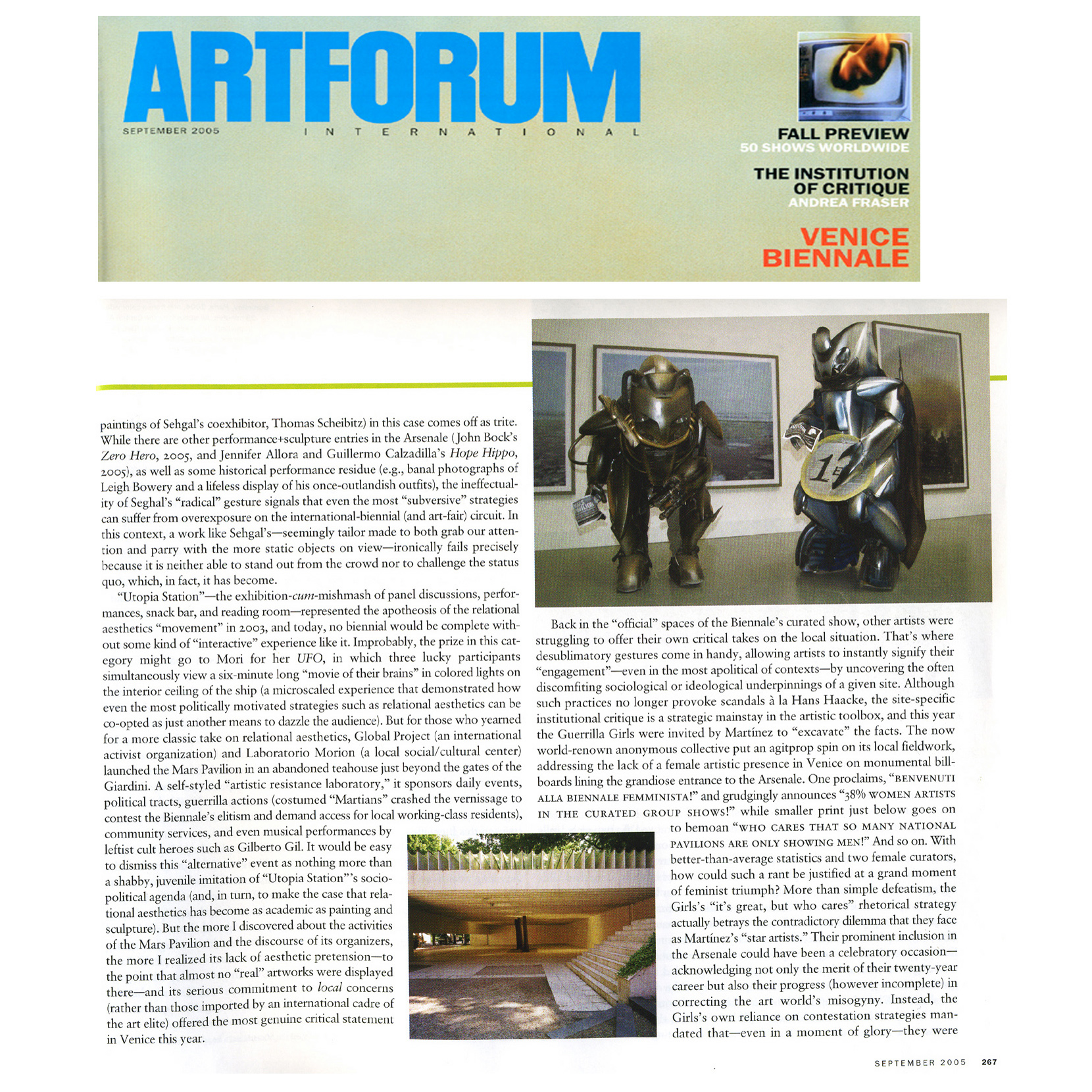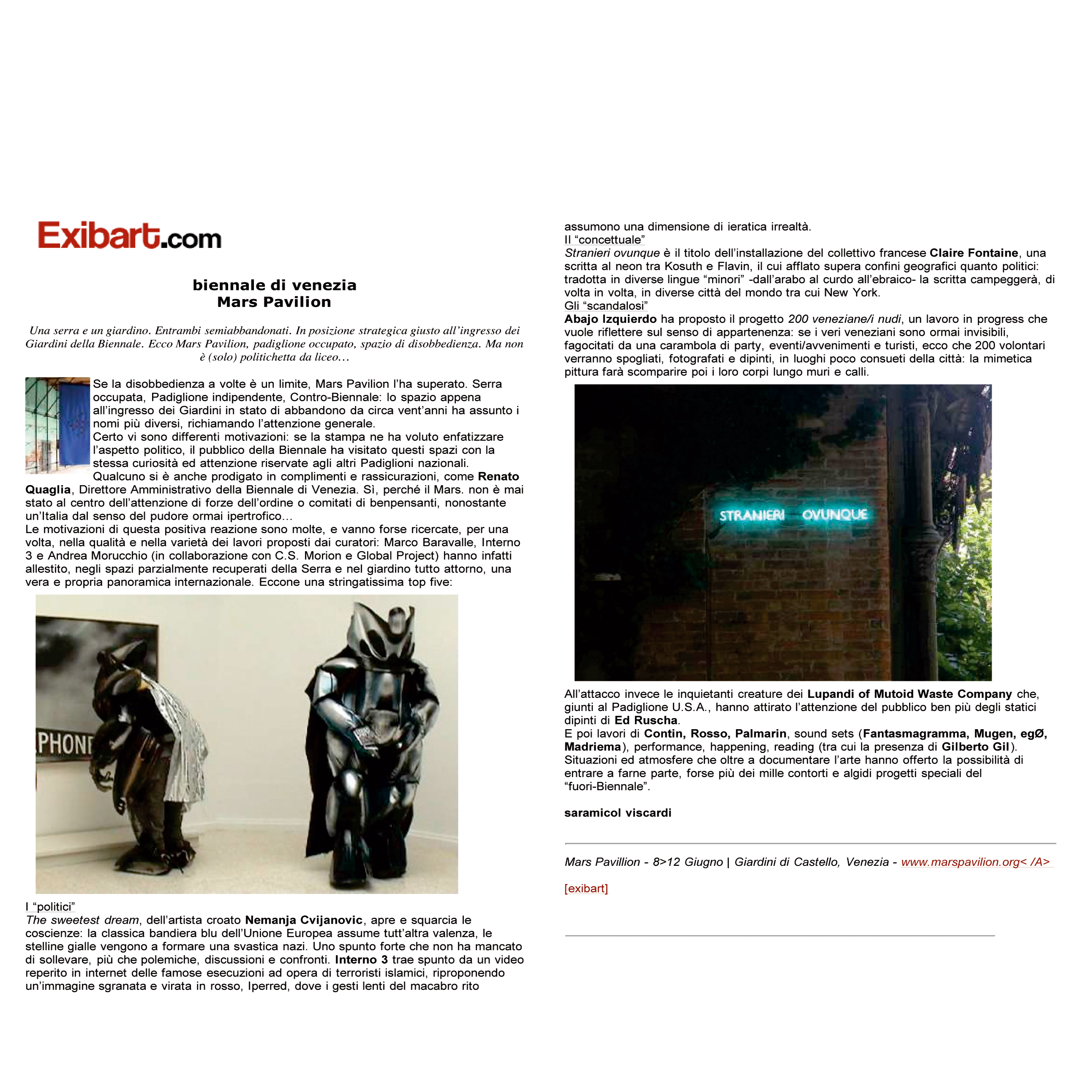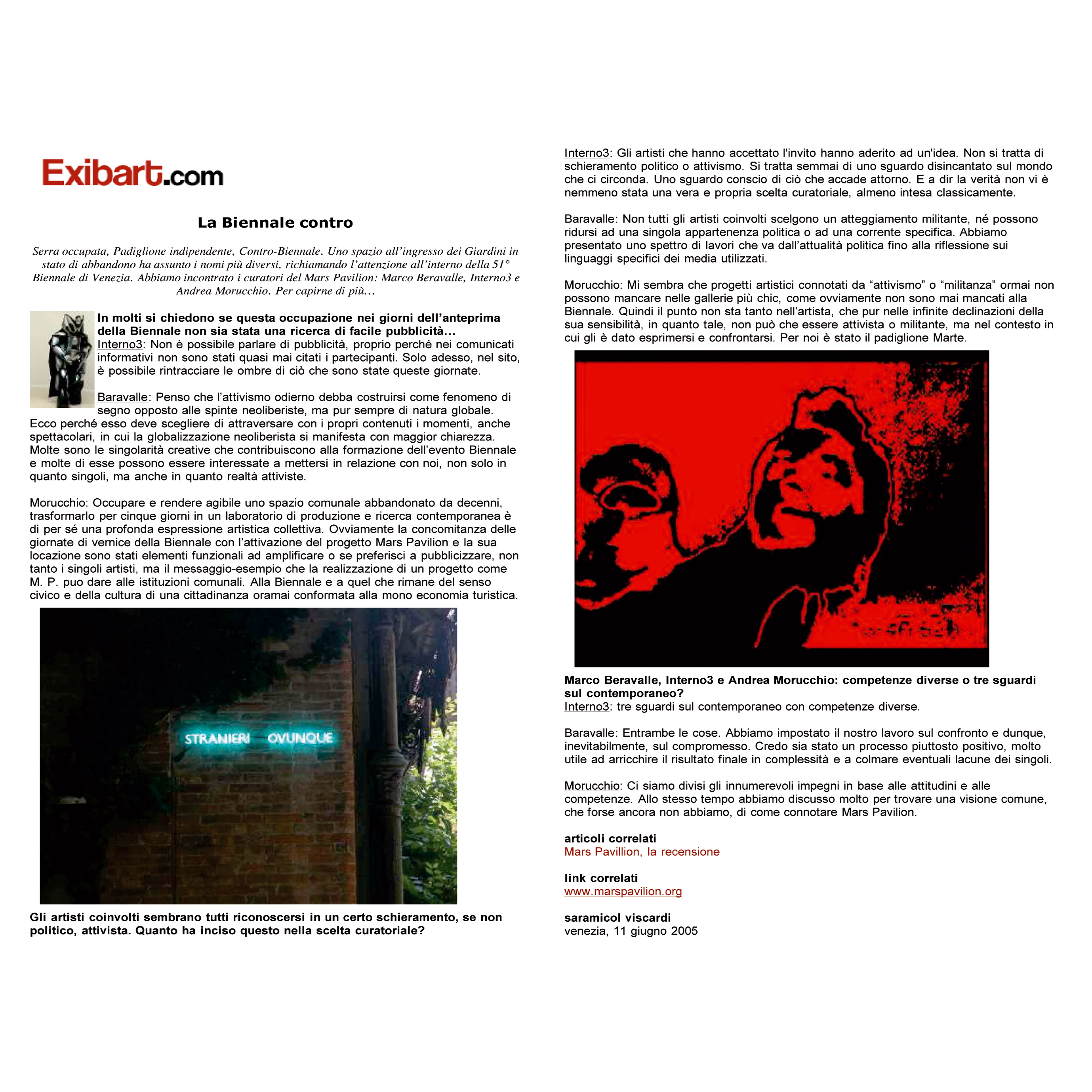MARS PAVILION | curatorial activity


MARS PAVILION | curatorial activity
Mars Pavilion Artistic Resistance Laboratory Giardini di Castello Greenhouse and urban intervents, Venezia 8.06_12.06 2005 Curated by Andrea Morucchio, Manuel Frara, Marco Baravalle In collaboration with Laboratorio Morion, Globalproject, Radio Sherwood
Artists: Stefano Bettini - Andrea Contin - Matteo Rosso - Andrea Morucchio - Shoggot - Matteo Peterlini - Alex Contarin - Giacomo Verde - Interno3 - Nikola Uzunovski - Ries Straver - Fantasmagramma - Mugen - egØ - Madriema - 155a.org - Lello Voce - Claudio Calia - Paolo Vassalli - Commons Creative Group - Raffaella Crispino - Anja Puntari - Abajo Izquierdo - Josè Hidalgo Escuelantigua – Piccologruppolento - Ukulele Oro Subito - A. S. C. terra paglia – progettozeropiu – Andres Torga - Pirats - Mauro Pirredda - Base Analogica - Lupandi of Mutoid Waste Company - Gianpietro Scarpa - Claire Fontaine - Nemanja Cvijanovic Reading and talking about: Gilberto Gil - Beppe Caccia - Marcello Tarì - Marco Baravalle - Lara Facco - Roberto Ferrucci Design: Manuel Frara & Matteo Rosso
Mars Pavilion, artistic resistance laboratory in the heart of the 51st Biennale, opens June 9th but it is not abruptly born just a few days before the Biennale of Venice rt exhibition's grand opening, nor will it definetely close once official kermesse is over. Mars Pavilion is a stage of a route, it is the starting point where a series of (political, cultural, artistic) collectives and inviduals chose to temporarly converge to become visible in a consistent try-out. Mars Pavilion is a hyper-pavilion. Its being radical mainly stands in the reflection about arts and their context: a purely and solely artistic context cannot become satisfactory vehicle to all those productions that today aim to be talking about our world, our society and about globalisation. Mars Pavilion is the result of collective labour and it therefore does not follow a specific theory. It for instance does not believe that traditional aesthetics - i.e. the institutional expo - should be overwhelmed. We are well aware of the constitutional value of the exhibition's formula, but Mars Pavilion finds its own strength in being an occupied space, which comes as a precise political strategy and as a social action attitude that most seriously read the relation with its territory. This does not mean that Mars Pavilion's goals are set in a national and provincial mentality, it actually means that Mars Pavilion aims to be part of the irreducible flows that are global protests against neoliberism, which tries to neutralise differences, creativity and radicality. Mars Pavilion stands in a paradox, in the involvement of aliens that cannot be alienated, of martians that are willing to self-detrminate thier lives on planet earth. We - martians - believe that experiencing life is absolutely central and this is why many of us chose to have political and social action deeply rooted in our every day life. We refuse to think that elections or benefits are the border of our influence in this society. We reclaim artistic experiences without banal conflicts or grotesque linguistic ingenuousness. We mean to experiment arts by overcoming institutional artistic milieu and aesthetisms, which are sometimes unignorable but which too often melt arts into an illusory mirage. Mars Pavilion can remind arts of their capacity of expressing a more complex panorama, made of territorial practices, of different interests and priorities, of social and extra-artistic relations, etc.
Art Forum - September 2005 | text extracted from "Stealing the Show" by Alison M. Gingeras
But for those who yearned for a more classic take on relational aesthetics, Global Project (an international activist organization) and Laboratorio Morion (a local social/cultural center) launched the Mars Pavilion in an abandoned teahouse just beyond the gates of the Giardini. A self-styled “artistic resistance laboratory,” it sponsors daily events, political tracts, guerrilla actions (costumed “Martians” crashed the vernissage to contest the Biennale’s elitism and demand access for local working-class residents), community services, and even musical performances by leftist cult heroes such as Gilberto Gil. It would be easy to dismiss this “alternative” event as nothing more than a shabby, juvenile imitation of “Utopia Station”’s sociopolitical agenda (and, in turn, to make the case that relational aesthetics has become as academic as painting and sculpture). But the more I discovered about the activities of the Mars Pavilion and the discourse of its organizers, the more I realized its lack of aesthetic pretension—to the point that almost no “real” artworks were displayed there—and its serious commitment to local concerns (rather than those imported by an international cadre of the art elite) offered the most genuine critical statement in Venice this year).
In the days of its inaguration, a stone's throw, better in the heart, of the Biennale the "Martians" landed. Mars Pavillion was the occupation that activists from the art world, the Morion laboratory and networks of precarious workers and students, broke into the Venetian scene. Manifesto of the collective work, of the planet of possibilities, of the planet open to conflict, a long video interview made to Toni Negri entitled >>> Art and Multitudo. Some of the protagonists spoke of "experiments in recomposition and working together on the fragments of sound, of image, of thought that flow chaotically in the multitude." These are Interior 3, video artists working along the track of radical deconstructivism. Andrea Morucchio, sculptor and viedo artist, speaks of Mars Pavillion as "a laboratory of geomancy, a place in which, that is, magnitude is created that attracts metropolitan creative lines of force and works on their excess."




artworks
books
media
essay
EXTRAS TEMPLATE